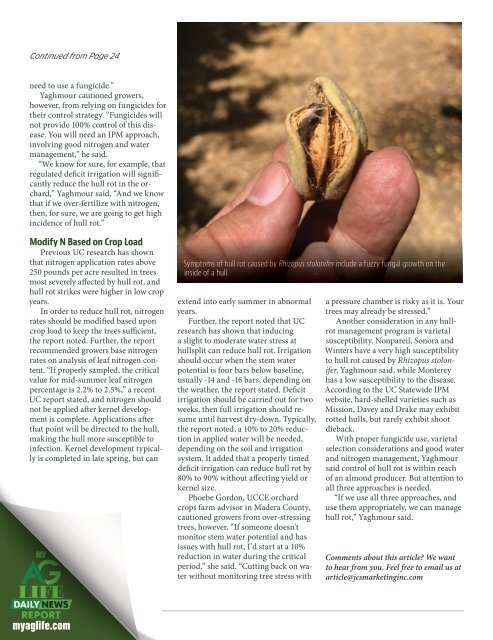Create successful ePaper yourself
Turn your PDF publications into a flip-book with our unique Google optimized e-Paper software.
Continued from Page 24<br />
need to use a fungicide.”<br />
Yaghmour cautioned growers,<br />
however, from relying on fungicides for<br />
their control strategy. “Fungicides will<br />
not provide 100% control of this disease.<br />
You will need an IPM approach,<br />
involving good nitrogen and water<br />
management,” he said.<br />
“We know for sure, for example, that<br />
regulated deficit irrigation will significantly<br />
reduce the hull rot in the orchard,”<br />
Yaghmour said. “And we know<br />
that if we over-fertilize with nitrogen,<br />
then, for sure, we are going to get high<br />
incidence of hull rot.”<br />
Modify N Based on Crop Load<br />
Previous UC research has shown<br />
that nitrogen application rates above<br />
250 pounds per acre resulted in trees<br />
most severely affected by hull rot, and<br />
hull rot strikes were higher in low crop<br />
years.<br />
In order to reduce hull rot, nitrogen<br />
rates should be modified based upon<br />
crop load to keep the trees sufficient,<br />
the report noted. Further, the report<br />
recommended growers base nitrogen<br />
rates on analysis of leaf nitrogen content.<br />
“If properly sampled, the critical<br />
value for mid-summer leaf nitrogen<br />
percentage is 2.2% to 2.5%,” a recent<br />
UC report stated, and nitrogen should<br />
not be applied after kernel development<br />
is complete. Applications after<br />
that point will be directed to the hull,<br />
making the hull more susceptible to<br />
infection. Kernel development typically<br />
is completed in late spring, but can<br />
Symptoms of hull rot caused by Rhizopus stolonifer include a fuzzy fungal growth on the<br />
inside of a hull.<br />
extend into early summer in abnormal<br />
years.<br />
Further, the report noted that UC<br />
research has shown that inducing<br />
a slight to moderate water stress at<br />
hullsplit can reduce hull rot. Irrigation<br />
should occur when the stem water<br />
potential is four bars below baseline,<br />
usually -14 and -16 bars, depending on<br />
the weather, the report stated. Deficit<br />
irrigation should be carried out for two<br />
weeks, then full irrigation should resume<br />
until harvest dry-down. Typically,<br />
the report noted, a 10% to 20% reduction<br />
in applied water will be needed,<br />
depending on the soil and irrigation<br />
system. It added that a properly timed<br />
deficit irrigation can reduce hull rot by<br />
80% to 90% without affecting yield or<br />
kernel size.<br />
Phoebe Gordon, UCCE orchard<br />
crops farm advisor in Madera County,<br />
cautioned growers from over-stressing<br />
trees, however. “If someone doesn’t<br />
monitor stem water potential and has<br />
issues with hull rot, I’d start at a 10%<br />
reduction in water during the critical<br />
period,” she said. “Cutting back on water<br />
without monitoring tree stress with<br />
a pressure chamber is risky as it is. Your<br />
trees may already be stressed.”<br />
Another consideration in any hullrot<br />
management program is varietal<br />
susceptibility. Nonpareil, Sonora and<br />
Winters have a very high susceptibility<br />
to hull rot caused by Rhizopus stolonifer,<br />
Yaghmour said, while Monterey<br />
has a low susceptibility to the disease.<br />
According to the UC Statewide IPM<br />
website, hard-shelled varieties such as<br />
Mission, Davey and Drake may exhibit<br />
rotted hulls, but rarely exhibit shoot<br />
dieback.<br />
With proper fungicide use, varietal<br />
selection considerations and good water<br />
and nitrogen management, Yaghmour<br />
said control of hull rot is within reach<br />
of an almond producer. But attention to<br />
all three approaches is needed.<br />
“If we use all three approaches, and<br />
use them appropriately, we can manage<br />
hull rot,” Yaghmour said.<br />
Comments about this article? We want<br />
to hear from you. Feel free to email us at<br />
article@jcsmarketinginc.com<br />
26 <strong>West</strong> <strong>Coast</strong> <strong>Nut</strong> <strong>April</strong> <strong>2021</strong>


















